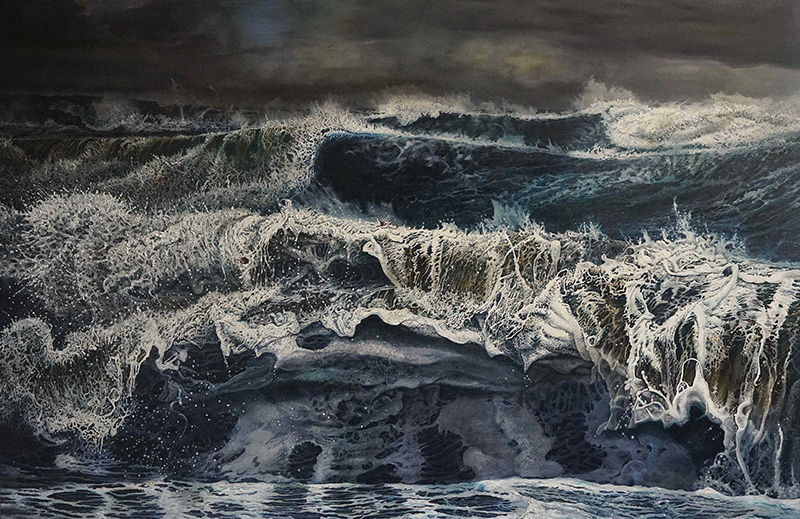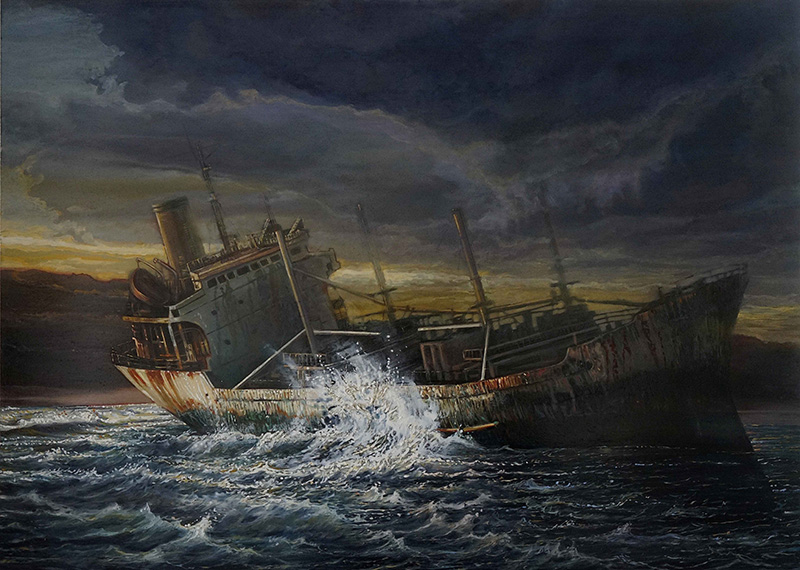INTERVIEW: Dimitris Tzamouranis
 Dimitris Tzoumouranis has been living and working in Berlin since the ‘90s, his career is remarkable, he is collaborating with Galerie Michael Haas in Berlin and Switzerland, and an artwork from his latest series of paintings is on presentation at the exhibition “ANTIDORON-The EMST Collection” in documenta 14 in Kassel with artworks from the Collection of National Museum of Contemporary Art (EMST)-Athens, curated by Katerina Koskina the Museum’s Director. The occasion of his Interview is his latest solo exhibition entitled “Mare Nostrum”, where, through the waves of the beautiful Mediterranean Sea, emerges the biggest problem of our era, Migration. Starting from the Roman expression, that serves and as the title of the exhibition, the artist through his canvas unfolds the contemporary history of the Mediterranean Sea that causes terror and awe, as it has been mutated to a huge wet cemetery that shallows souls, moral senses and especially the dream and the desire for a better future. As Dimitris Tzamouranis says “Searching for a better new world is a utopia. The best world is the one that you live and feel free. But when they destroy your world nothing is left but to escape”.
Dimitris Tzoumouranis has been living and working in Berlin since the ‘90s, his career is remarkable, he is collaborating with Galerie Michael Haas in Berlin and Switzerland, and an artwork from his latest series of paintings is on presentation at the exhibition “ANTIDORON-The EMST Collection” in documenta 14 in Kassel with artworks from the Collection of National Museum of Contemporary Art (EMST)-Athens, curated by Katerina Koskina the Museum’s Director. The occasion of his Interview is his latest solo exhibition entitled “Mare Nostrum”, where, through the waves of the beautiful Mediterranean Sea, emerges the biggest problem of our era, Migration. Starting from the Roman expression, that serves and as the title of the exhibition, the artist through his canvas unfolds the contemporary history of the Mediterranean Sea that causes terror and awe, as it has been mutated to a huge wet cemetery that shallows souls, moral senses and especially the dream and the desire for a better future. As Dimitris Tzamouranis says “Searching for a better new world is a utopia. The best world is the one that you live and feel free. But when they destroy your world nothing is left but to escape”.
By Dimitris Lempesis
Photo: Dimitris Tzamouranis Archive
Mr. Tzamouranis, the title of your solo exhibition at Galerie Michael Haas is twofold, “Mare Mostrum” was the term used by Romans for the Mediterranean Sea but also the name of the naval and air operation commenced by the Italian government to tackle the increased immigration to Europe the period 18/10/13-31/10/14. Why did you choose this title for your exhibition and what does it mean for you?
Mare Nostrum means “Our sea”, because in the Roman era Mediterranean Sea did not represent the unexplored and scary unknown, but the sea that united the ancient world. Also “Mare Nostrum” was the code name of the very successful operation of the Italian government for the rescue of the refugees. Unfortunately, after political pressure from Brussels, “Mare Nostrum” was replaced by Frontex’s “Operation Triton”, that basically has nothing to do with the rescue of refugees but with the safeguarding of EU’s borders. Since the operation began the number of migrants who drowned while crossing the Mediterranean has dramatically increased. Τhis policy change gave me the impetus for the title of the exhibition, perhaps as an emotional reaction to the tragic consequences.
In your paintings that depict the stormy sea, the titles are geographical coordinates, how did this idea arise? Is it a comment on today’s reality?
In the summer of 2015 when I was in Kalamata, Greece with Kathrin Lind, my partner in life, the refugee crisis was at its peak. We were sailing almost every day with my boat, at some point we realized that we may have gone endlessly over the scenes of lost human lives. Essentially this was the reason why we decided to make our trip more specific by visiting the geographical coordinates of the shipwrecks. Perhaps because of the feeling that we can’t change anything, as an artist I wanted to react. We asked for the coordinates of the shipwrecks from the port authorities of Kalamata and sailed these areas, trying to understand the tragedies that have evolved there and the effect these sites had on us. Ι purposely entitled every artwork with the geographical coordinates we visited, thus the paintings act as the monuments of a catastrophe that has left no recognition points in the seascape, only geographic coordinates as reference points.
Although Mediterranean Sea has been transformed into a wet cemetery, you choose as the central theme in your paintings only the stormy sea. What does this attitude means?
Upon the return in my studio in Berlin, I started this series of the paintings based on sketches, notes and photos from the sites we had visited. But soon I understood that I must disengage my paintings from the pressure to express my experience naturalistically. I painted the catastrophe in a toxic-influenced wet landscape. The stormy sea became anthropomorphic, full of demonic forms.
Is it Denial or Aversion towards a social problem that has been a serious concern for the Europeans citizens in recent years, creating multiple problems in their lives and everyday life?
What disturbs me the most, is the great apathy of the mass media regarding the refugee crisis. They usually focus on political purposes rather than the tragedy of the protagonists.
Mr. Tzamourani, you are a Greek artist living and working in Berlin for the last 20 years and you have a successful career and life, what does migration means to you and how affect you the images of people looking for a better world?
As a young artist I start working in Berlin in the early 90’s, not by necessity but because the European borders of were open, just after the fall of the Berlin Wall. Essentially it was a very personal decision and choice. My generation believed in the idea of united Europe. Unfortunately we have a massive reversal of what is happening in recent years. Searching for a better new world is a utopia. The best world is the one that you live and feel free. But when they destroy your world nothing is left but to escape. As an artist I am trying to increase the viewer’s awareness through my artwork, I believe in the idea of art and the humanism that art expresses historically. Through art the societies can come up against the political brutality and its stupid representatives.
The seascapes that are on presentation in the exhibition have geographical position-orientation they do not refer to an atopy, contrary to your “Shipwreck” series that havs not a specific stigma or geographic identification.
Each shipwreck is recognizable in the landscape. We met them in our journey thrown on the rocks of the coast. Usually their captains throw them deliberately ashore to disembark the fugitives on the land without το be discovered.
In contrast to the large-scale of the “Seascapes” series you decided to portray the Shipwrecks on small-scale paintings. ? Do you think that a dramatic subject is rendering better in small size?
At the one hand, in the seascapes I tried to render the wild energy of nature through the microscopic and macroscopic form and abstraction. For that reason I chose the large size. On the other the small-scale paintings of the shipwrecks represent the powerless human being and it’s artifacts against the vast nature.
Info: Galerie Michael Haas, Niebuhrstraße 5, Berlin, Duration: 23/6-29/7/17, Days & Hours: Mon-Fri 9:00-18:00, Sat 11:00-14:00, www.galeriemichaelhaas.de
First Publication: www.dreamideamachine.com
© Interview-Dimitris Lempesis





